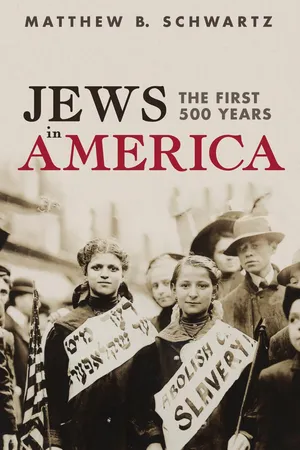
This is a test
- 308 pages
- English
- ePUB (mobile friendly)
- Available on iOS & Android
eBook - ePub
Book details
Book preview
Table of contents
Citations
About This Book
Using a readable question-and-answer format, Jews in America: The First 500 Years presents the activities of Jews in America since the beginnings of European settlement. It tells something of the story of how Jews came to the "golden land" and what they have done here--men and women, scientists and athletes, soldiers and merchants, settlers and scholars. It is indeed a remarkable story.
Frequently asked questions
At the moment all of our mobile-responsive ePub books are available to download via the app. Most of our PDFs are also available to download and we're working on making the final remaining ones downloadable now. Learn more here.
Both plans give you full access to the library and all of Perlego’s features. The only differences are the price and subscription period: With the annual plan you’ll save around 30% compared to 12 months on the monthly plan.
We are an online textbook subscription service, where you can get access to an entire online library for less than the price of a single book per month. With over 1 million books across 1000+ topics, we’ve got you covered! Learn more here.
Look out for the read-aloud symbol on your next book to see if you can listen to it. The read-aloud tool reads text aloud for you, highlighting the text as it is being read. You can pause it, speed it up and slow it down. Learn more here.
Yes, you can access Jews in America by Matthew B. Schwartz in PDF and/or ePUB format, as well as other popular books in History & North American History. We have over one million books available in our catalogue for you to explore.
Information
1945–1980
Cross-Currents
A new era began with the end of World War II. Jewish life in the U.S. in those years can perhaps be best understood in terms of a pattern of cross currents, as people moved from one form of Judaism to another, or into or out of Judaism altogether. Jews were in the forefront of all the great social movements—civil rights, feminism, and the protest against the Vietnam War.
Large numbers of GI’s returning from the Second World War prompted a growth of new housing, and Jews moved en masse to the suburbs. Many major cities were empty of Jews by the 1970’s. Jews who remained in mixed urban neighborhoods, especially in New York, were occasionally victims of the eruptions of urban tensions involving both individual violence and mob incidents in which synagogues and Jewish buildings were attacked.
Jewish families were caught up with everyone else in the great change in family structure. Family units typically were small, except among the yeshiva oriented. By the 1970’s growing numbers of young Jews were not marrying at all, or were marrying out of the faith, and divorce rates grew.
American Jews paid close attention to developments in Israel, visiting and contributing huge sums of money. They watched anxiously as Israel defended itself in a series of wars against intransigent Arab neighbors. For some Jews, Zionism became almost a substitute for religion.
On the religious front, Conservative Judaism reached a peak in the 1950’s and 60’s, building large synagogues in the growing suburbs. Congregations became increasingly liberal, adopting innovations like bat mitzvah celebration, the triennial Torah reading cycle, and women rabbis. A generation of new young rabbis had fewer links with Orthodox Eastern European antecedents. The old guard at the Jewish Theological Seminary, men like Louis Ginzberg, Louis Finkelstein, Abraham Joshua Heschel and Saul Lieberman were aging and passing from the scene.
Reform congregations grew both in size and in scope of activity. Reform embraced Zionism by 1948 and began to reintroduce bar mitzvah and to introduce bat mitzvah celebrations to the temples. The rabbi and cantor were more likely to wear a talit, prayer services used more Hebrew, and more congregants prayed with their heads covered. Old German families were still prominent, but the Eastern European families also joined the leadership. The new Reform prayer book, adopted in 1976, reflected both the diversity within Reform and the growing interest in tradition.
Orthodox refugees, who had survived Nazi Europe, brought a new dose of yeshiva educated Jews to the U.S. after World War II, and helped spark the resurgence of day schools and advanced yeshivot. By the 1960’s, a new self-confident Orthodoxy began to show itself. Large Hasidic enclaves developed, notably the Lubavitch community in Crown Heights and Satmar in Williamsburg, New York. In the 1950’s many traditional synagogues were turning Conservative, but this trend slowed greatly as Orthodoxy reasserted itself.
Jews continued to make important contributions, far out of proportion to their numbers, in many fields. They served in government and, at one point in the 1980’s, seven Jews sat in the U.S. Senate.
Q. How did the U.S. government deal with immigration after World War II ?
A. After World War II, Europe was filled with people whose lives were totally uprooted. Congress passed a Displaced Persons Act in 1948, as a temporary measure, to allow almost 500,000 refugees to enter the U.S. over the next several years. Sixteen percent of the refugees were Jews. In 1952, the McCarran-Walter Act passed through Congress over President Truman’s...
Table of contents
- Title Page
- Acknowledgements
- Preface
- Abbreviations
- Introduction
- 1492-1802: Colonial Days
- 1802-1850: German Jewish Immigration
- 1850-1881: Civil War and Expansion
- 1881-1924: Eastern European Immigration
- 1924-1945: Americanizing
- 1945-1980: Cross-Currents